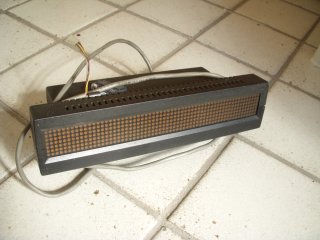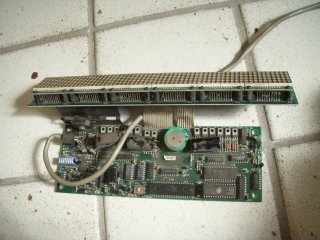Kiko
| You are here: Kiko > PostsInEnglish > EnBlogEntry2008Jan03A | Printable | topic end |
Start of topic | Skip to actions

80's-looking retro style | |

|
New Toy in the Junkbok: a LED Matrix Display
Rec 02-jan-2008 21:40 Every time I go to São Paulo, I always find a way to spend some time scavenging the surplus "as-is" stores on Santa Ifigênia Street. Plus, many friends developed a habit of giving their broken electronics to me. Combined with my recent lack of spare time to play with my electronic toys, the junkbox has been piling up to hitherto unprecedented levels. During the new year holidays, I finally got some time to take a look at some of the stuff in there. Standing in the junkbox were two heavy bulky led matrix display units I got for US$ 15 apiece. At a glance, they have twelve 1.7" 5x7 led matrix displays with no spacing between them, giving a total of 60x7 pixels. This means it can display up to ten 5x7 characters or fifteen 4x5 characters. But the good surprise came when I disassembled one of the units and tested the displays: they are bi-color displays. Trying to buy a single of them alone new would cost about US$ 10, so getting twelve of them plus lots of other components for US$ 15 was not bad at all. I tested every single pixel by connecting a 9V battery and a current limiting resistor to every pin connected to the displays and they were all good. Perhaps the device has been scrapped because the driving electronics was bad. Sure enough, trying to connect it to the serial port didn't work. The device came with a bulky 3A 8VAC power supply brick. The rather high 3A current rating is understandable -- multiplexing by column, we'd have at most 14 leds simultaneously on. LEDs are rated to sustain about 20mA continuous current, but if in brief bursts, it may be a lot more. Dividing 3A by 840 leds (60x7x2) yields about 3.5mA avarage current per led when they're all on. Due to the multiplexing, I'd probably guess the device drives each led with about 100mA, yielding ~1.4A maximum power consumption. So the 3A rating gives a reasonable headroom. The display board consisted of six boardlets right next to each other, each with two 5x7 displays. In each boardlet, the connections seemed pretty straightforward: two groups of seven leads above connected to the cathodes of the lines; and a group of ten leads below connected to the anodes of each column/color. Underneath there is a board with what seem to be darlington driver ICs. I quickly found out that the cathodes are directly connected to a flat cable leading to a bank of power transistors in the main board. There was another flat with what seem to be the multiplexer signals. The main board had something that looked like a microcontroller, right next to an EEPROM chip. In amost every device I get has at least one uncommon, hard to find component. The one here was a 5.5V 1F supercapacitor. No, it's not one microfarad, it's one farad! I always wanted to test one of these aganst certain batteries and seems like now I got my chance. All in all, it doesn't seem too hard to replace the main control board with something I can cook up with my AVR MCUs.top
